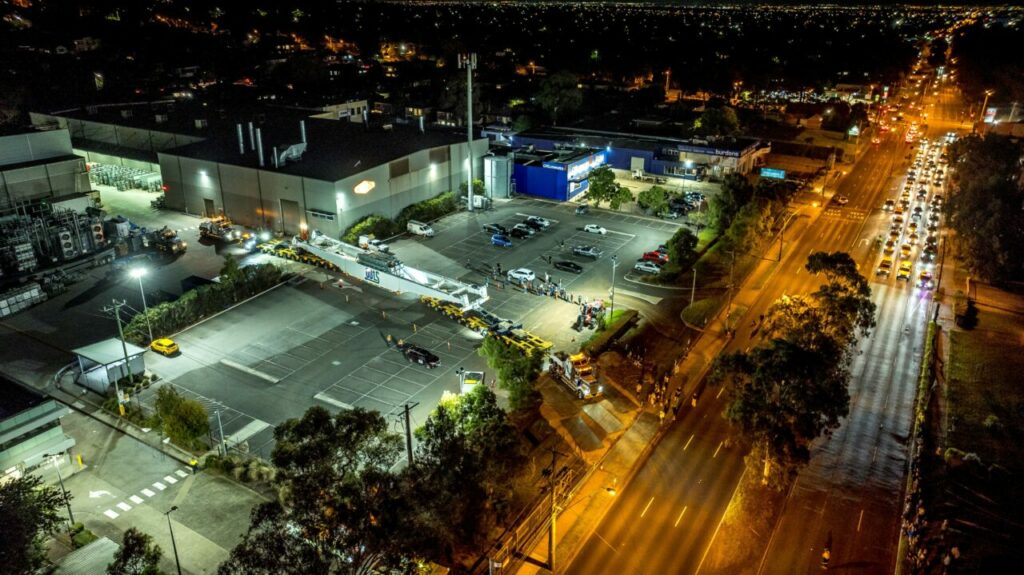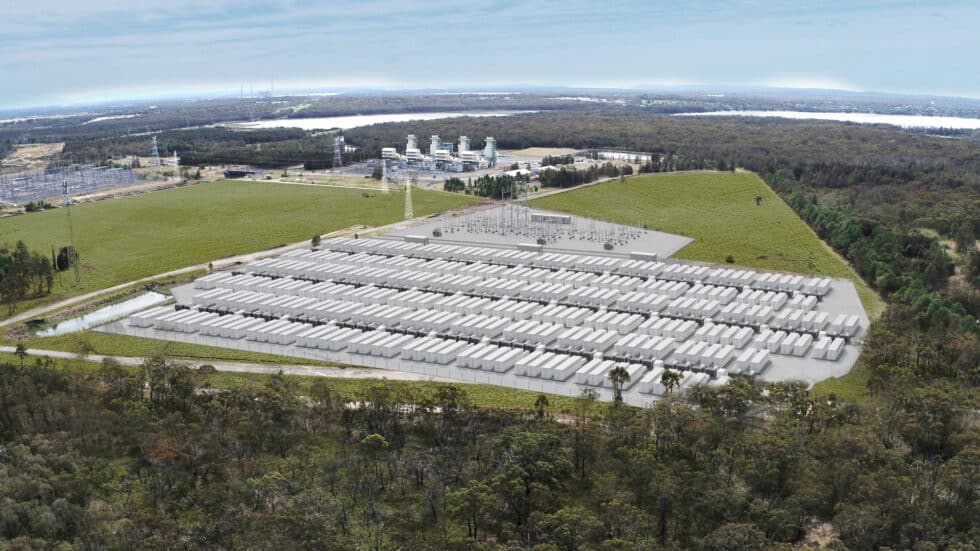
Energy-Storage.news speaks with Danny Lu of Powin about some of the system integrator’s thoughts on the Australia market and delivery of the Waratah Super Battery.
Australia’s energy storage sector is in a high growth phase. As of the end of 2023, 5GW/11GWh of large-scale battery energy storage system (BESS) projects were in construction, according to the Clean Energy Council (CEC) trade group.
Enjoy 12 months of exclusive analysis
- Regular insight and analysis of the industry’s biggest developments
- In-depth interviews with the industry’s leading figures
- Annual digital subscription to the PV Tech Power journal
- Discounts on Solar Media’s portfolio of events, in-person and virtual
Or continue reading this article for free
That was a big jump from the 1.4GW/2GWh in construction a year earlier, speaking to a growth in average duration as well as seeing the number of projects grow.
The biggest BESS in construction as 2023 ended was the Waratah Super Battery, a government-backed project in New South Wales (NSW) which is expected online in 2025.
US system integrator and manufacturer Powin is delivering the BESS equipment to Waratah Super Battery for developer Akaysha Energy, and the system is designed as a “giant shock absorber for the grid,” to quote the NSW government’s own description.
That role will be played through a System Integrity Protection Scheme (SIPS) contract, which ensures that it will be available to protect the network from major disruptions in electricity supply, essentially providing a buffer of power.
Danny Lu, Powin’s executive vice president, says the company sees great potential in the Australian market and is excited to be there.
Working on such a major project, and working within the often unique structures and dynamics of the country’s electricity sector does come with some challenges too, Lu explains.
Progress report
The Super Battery’s 477-tonne high-voltage transformer arrived onsite early this year, and it made mainstream news headlines in the region given its sheer scale. Lu says this milestone is a significant part of a construction and commissioning process that is running on time.
“As of now, the high-voltage transformer has been delivered, most of the power conversion systems (PCS) have been delivered, and the battery stacks and collection segments are in the process of being delivered.
We’re still on track to meet the delivery dates, and we’ll commission the system block-by-block. There’ll be a lot of ‘parallel’ work happening. As the last part of the site is being finished, we will commission some of the first parts of the site.
We want to really get ahead of the commissioning process, so we’ve established these tests labs in Tualatin (Oregon, US) as well as locally in New South Wales, to be able to simulate the tests that we’re going to be completing onsite. We want to be able to get as much done in a lab setting using real equipment, as well as the models that have been approved by the Australian Energy Market Operator (AEMO) to be able to expedite the commissioning process.”
‘Different and demanding’ grid connection process
In April, Energy-Storage.news reported that the project had received its key Generator Performance Standard (GPS) approval from AEMO. That means AEMO determined the Super Battery’s design met performance requirements for transmission-connected generation or storage. Akaysha CEO Nick Carter noted that getting approval took around a year in total, and various sources have said that connecting storage to the grid in Australia is a unique process and Danny Lu agrees there are big differences from grid connection standards and codes in other markets.
“It’s very different, but it’s also demanding. AEMO is trying to protect the grid’s stability and integrity. Certain parts of Australia’s grid are fairly congested, so the Generator Performance Standard (GPS) aims to ensure that these systems and the new generation and power being deployed onto the grid do not harm the grid in any way.
Recently, they’ve also announced system strength measures, where all new storage needs to be grid-forming [capable of providing inertia and other stability services] to be interconnected to the grid without a large penalty. I think that adds a bit of complexity to what was already complex, but I think it’s necessary for them to accomplish their goals of having a hardened and reliable grid for the future.”
By the time Waratah was contracted, the announcement (which happened about a year ago) still had not been made. So, we were able to grandfather in the grid-following functionality, but we are planning on switching it over to grid-forming, probably within 12 to 24 months of commissioning.
At Ulinda Park, [Powin’s other project for Akaysha, a 150MW/300MWh system in Queensland], interconnection was also applied for prior to the announcement, but both of these are grid-forming compatible, and all the hardware can be grid-forming. We just need to go through the process with AEMO again to approve the grid-forming version of the models.
I think Australia is ahead of its time in mandating this. Australia is definitely a leader in terms of thinking about its grid holistically and trying to establish solutions for problems that may arise in the future. They’re thinking ahead.”
Local content strategy helped get transformer onsite, on time
Regular readers will know that the battery supply chain crunch the industry experienced for much of the pandemic, with lithium prices rising and peaking in 2022, has thankfully eased.
However, long lead time equipment has become a tricky supply chain conversation in its stead, with transformers in high demand and delivery times extending to several times what might have been seen in years past. Lu says Akaysha’s strategy of buying local helped mitigate the procurement challenges Waratah Super Battery might otherwise have faced.
“Transformers are definitely a bottleneck for many renewable energy projects being installed in the next few years.
I think Akaysha really wanted to utilise a local content strategy for the transformers. So, they’re utilising a local Australian vendor named Wilson Transformer Company, which was able to provide them with a priority production slot for the Waratah project, because it was considered an infrastructure security type of project. Having that local supplier of transformers helped with the global lead time issues that everybody has been seeing in the transformer market.
All medium- and high-voltage transformers were manufactured in Australia for the Waratah project.”
SIPS contract
The SIPS contract has been signed with EnergyCo, which is a NSW authority tasked with implementing the state’s Electricity Infrastructure Roadmap. Akaysha Energy won its contract through a competitive solicitation, agreeing to provide 700MW/1,400MWh of shock-absorbing power and energy from the 850MW/1,680MWh BESS.
“The System Integrity Protection Scheme means a project needs to be designed for the highest availability. We need to provide close to 100% fully guaranteed availability on the 700MW, but we’ve oversized the project to 850MW to be able to provide some level of redundancy.
If certain parts of the PCSs [fail], or if a transformer blows, things that you cannot predict happen on the project, we would have to see a large percentage of the project fail to be below that 700MW requirement.
We’ve designed, in partnership with Akaysha, to oversize the power of the project, and then be able to have some level of cushion or tolerance to ensure that the 700MW is consistently delivered. There are large penalties associated with missing these signals, so we wanted to ensure protection for Akaysha as well as Powin to have that redundancy built in.

The added benefit of the oversize is that it allows you to have some protection over SIPS, but it also allows you during non-SIPS times, to have some additional power to make additional revenues for the project.
[In terms of the 2-hour duration] The SIPS signals will come once every 30 minutes if needed and a maximum of four times in a row, which gets you to the two hours (1,400MWh).”
Some other unique or unusual aspects of the Australian market
Lu says that in addition to the two projects it has already secured and announced with Akaysha Energy, Powin has a number of other projects in Australia that are at late stages of GPS certification processes.
Customer names cannot be revealed just yet, but they signify the “exciting” potential of the Australian market, he says, but companies aiming to join Powin in tapping the opportunities need to be ready to face a steep learning curve based on its unique qualities.
“There’s a lot of quirks to the Australian market. GPS is just one of them, but we’ve also had to go through a lot of learnings in terms of product design. We needed to think about bushfire compliance and design some special webbing within the product. We’ve also needed to go through AS3000, a local wiring protocol, or standard.
So, there are a lot of different things that companies need to do to get ready to come to Australia. In addition to those product-style compliances, we’ve hired over 20 people locally in Australia to really support our projects and allow our customers to feel like we’re supporting them in their timezone. We’re investing locally, and we’re creating a team that is widely capable of decision-making and problem-solving within the local country.”
This week, Energy-Storage.news’ publisher Solar Media will host the 1st Energy Storage Summit Australia, on 21-22 May 2024 in Sydney, NSW. Featuring a packed programme of panels, presentations and fireside chats from industry leaders focusing on accelerating the market for energy storage across the country. For more information, go to the website.
